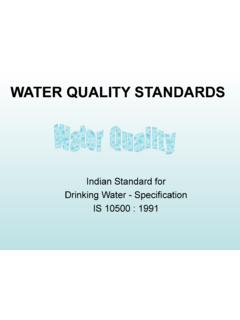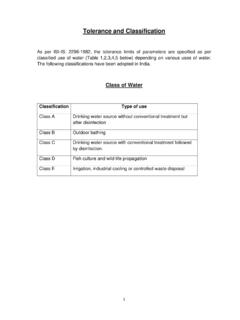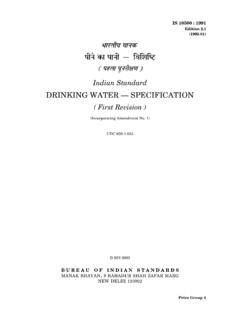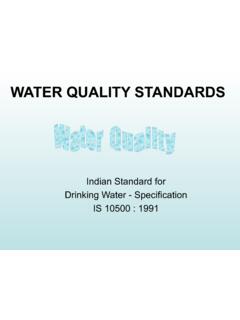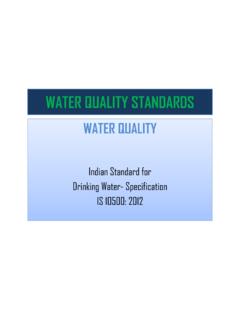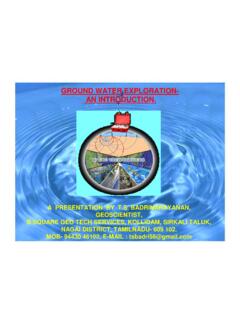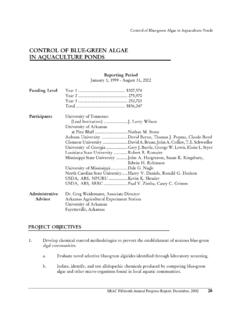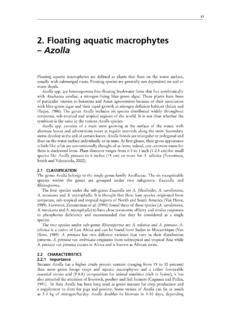Transcription of Agriculture and Environmental Pollution - India …
1 Agriculture Agriculture and and Environmental PollutionEnvironmental PollutionDr P S HarikumarScientist and HeadWater Quality Division, production and increased efficiencyAgricultural PolicyIntensification of the farming system Increase of Pollution risks Linkages between policies, driving forces and the state of the environment relevant to water Source: OECD Secretariat, 2010 Agricultural Pollution Contamination of the soil, air and water environments resulting from farming activities The primary agricultural nonpoint source pollutants: nutrients (particularly nitrogen and phosphorus) sediment sediment wastes pesticides of agricultural of agricultural ) Public healthIn drinking water, high concentrations of nitrate can causemethemoglobinemia( blue baby syndrome), a potentially fataldisease in Problem2) Fish stocks and marine (a) spawning areas for economically valuable fish(b) habitats for other marine life3) The tourist industryPoisonous and odorous coastal waters discourage tourists!
2 Biodiversity LossLoss and degradation of habitat fromclearing grasslands and forests anddraining wetlandFish kills from pesticide runoffKilling of wild predators to protectlivestockLoss of genetic diversity fromreplacing thousands of wild cropSoilErosionLoss of fertilitySalinizationWaterloggingDeserti ficationreplacing thousands of wild cropstrains with a few monoculture strainsHuman HealthNitrates in drinking waterPesticide residues in drinking water,food, and airContamination of drinking andorganisms from livestock wastesorganisms from livestock wastesBacterial contaminationAir PollutionGreenhouse gas emissions from fossilFuel issueOther air pollutants from fossil fuel usePollution from pesticide spraysWaterWater wasteAquifer depletionIncreased runoff andflooding from land clearedto grow cropsSediment Pollution fromerosionSurface and groundwaterpollution from pesticidesand fertilizersOverfertilization of lakesand slow-moving riversfrom runoff of nitrates and phosphates fromfertilizers, livestockwastes, and fooderosionFish kills from pesticiderunoffwastes.
3 And foodprocessing wastesFertilizersTYPES OF FERTILIZERSI norganic fertilizersLiquid fertilizers Nitrosol and African Violet FoodSlow-release fertilizersFertilizer with insecticidesPesticides Pesticide covers a wide range of compounds -insecticides,fungicides,herbicides,rode nticides,molluscicides,nematicides,plant growthregulatorsregulators India - steady growth in the production oftechnical grade pesticides (5,000 metric tons in1958 to 102,240 metric tons in 1998)PesticideuseinIndia1948:DichloroDip henylTrichloroethane (DDT) and Benzene Hexa Chloride (BHC) formalaria is the leading manufacturer of basic pesticides in Asia and ranks 12th globally Insecticides :61% of total consumptionfungicides (19%) and herbicides (17%). 54% of the total quantity of pesticides :cotton 17% : rice and 13% in vegetables and fruits.
4 76% of the pesticide used is insecticide, as against 44% globallyIndiaWorldConsumption pattern of pesticidesPesticide use in India 30% of the cropped area. Increased from , million hectares (1950) to 137 million hectares. Total consumption was the highest during the 1980s, post-green revolution. The declining trend observed later may be attributed to the increased awareness on negative externalities by the farmers or the changes in policies reducing subsidies. Consumption level of pesticides in Agriculture in Kerala (1995-96 to 2007-08) metric tonnes (MT) (2007-08) technical grade material of insecticides, fungicides, weedicides and rodenticides. Over the past 15 years, consumption reached the highest level of 1, MT in 1994-95 and 1, in 2001-02 and was the lowest at MT during 2003-04 and shows a gradual declining trend.
5 Kerala Agriculture contributes to Kerala s economy (as of 2002-2003). Pesticide consumption in Kerala and IndiaHow can Agricultural Pollutionharm our environment?How do different agricultural activities contributeto Pollution , and how does this affect our ground and surface waters??16 Agricultural impacts on water qualityAgricultural activityTillage/ploughingImpactsImpactsS urface waterSurface waterGroundwaterGroundwater17 Sediment/turbidity: sediments carry phosphorus and pesticides adsorbed to sediment particles;siltation of river beds and loss of habitat, water Pollution Direct surface runoff Seepage to ground water that discharges to a surfacewater outlet Various farming activities - erosion of soil particlesSediment produced by erosion - damage fish habitatwetlands , transports excess agricultural chemicalsresultingincontaminatedrunoffre sultingincontaminatedrunoff Excess nutrients from nonpointsources cause eutrophicationAgricultural activityImpactsImpactsSurface water Surface water GroundwaterGroundwaterFertilizers Runoff of nutrients, especially phosphorus,leadingtoeutrophicationcausin gtasteandLeaching of nitrate to19leadingtoeutrophicationcausingtastea ndodour in public water supply, excessalgae growth leading to deoxygenatingof water and fish of nitrate togroundwater.
6 Excessive levelsare a threat to public health. Groundwater Pollution Nitrate -most common chemical contaminant Mean nitrate levels - risen by an estimated 36%inglobalwaterwayssince1990inglobalwat erwayssince1990 India and Africa - 20-50% of wells in agricultureareas contain nitrate levels greater than 50 mg/l& in some cases as high as 100 mg/lAgricultural activity Manure spreading ImpactsSurface waterGroundwater21 Carried out as a fertilizer activity;Results in high levels of contamination ofreceiving waters by pathogens,metals, phosphorus and nitrogenleading to eutrophication andpotential of groundwater,especially by nitrogenAgricultural activity5. IrrigationImpactsSurface water Surface water GroundwaterGroundwater22 Runoff of salts leading to salinizationof surface waters; runoff of fertilizersand pesticides to surface waters with ecological damage, bioaccumulation in edible fish species, etc.
7 High levelsof trace elements such as selenium can occur with serious ecological damage and potential human healthimpacts. Enrichment of groundwater withsalts, nutrients (especially nitrate). ). Agricultural activityClear cutting ImpactsSurface water Groundwater23 Erosion of land, leading to highlevels of turbidity in rivers, siltation of bottom habitat, etc. Disruption and change of hydrologic regime,often with loss of perennial streams;causes public health problems due to loss of potable of hydrologic regime, often with increased surface runoffand decreased groundwater recharge; affects surface water by decreasing flow in dry periods and concentrating nutrients and contaminants in surface water. Agricultural activity24 ImpactsSurface water GroundwaterBroad range of effects: pesticide runoff and contaminationof surface water and fish; erosion and sedimentation problems.
8 Agricultural activityAquaculture ImpactsImpactsSurface waterSurface waterGroundwaterGroundwater25 Surface waterSurface waterGroundwaterGroundwaterRelease of high levels of nutrientsto surface water and groundwaterthrough feed and faeces, leadingto serious Handling, storage and disposal of chemicalagricultural inputs - cause cancer ,negativelyinfluence reproduction ,disrupt the endocrinesystem etc. Pesticide residues in food and drinking water -Health problems Pesticide residues in food and drinking water -cause similar adverse health effects Systems of Pokkali , Kuttanad and Kole - Irrigated as well as rain fed rice cultivation- in valleys ofmidlands and highlands CatchmentareaofKuttand-fertilizerandpest icideAgriculture Pollution in Kerala CatchmentareaofKuttand-fertilizerandpest icideconsumption increased significantly over the years Plantation Corporation of Kerala -aerial spraying ofEndrin (later Endosulphan) in cashew plantations -severehealth problemsPeriyar (5,400 km2, 244 km), Muvattupuzha (1,550 km2, 121km Meenachil (1,250km2, 78km Manimala (850 km2, 90km) Pamba (2,250 km2, 176km Achencoil (1,500 km2, 128km).)))
9 Coordinates: 9 10 40 N latitude 76 77 30 E longitudeArea: 151250 haElevation: - m below MSL Input of large quantities of agrochemicals and pesticides The annual usage of pesticides/fungicides/weedicides inKuttanad -117 tones during Virippu season , 368 tonesduringtheMundakanandPunchaseasonPol lution of Vembanad backwater systemduringtheMundakanandPunchaseason Annual fertilizer consumption - 8409 tones of nitrogen,5044 tones of potassium Aggressive waterweeds and water pollutionTo check the floodwaters from Achenkovil, Manimala and Pamba Rivers during monsoons, a spillway was constructed at Thottapally in 1955 which divert the water to the Arabian Sea. To prevent salt water intrusion and to promote To prevent salt water intrusion and to promote double crop of rice in about 55000 ha of low lying fields in the area, a barrage at Thanneermukkom in the Vembanad Lake was constructed in1975 with facilities for allowing navigation and this remains closed from December to May every year.
10 Agricultural practices Construction of barrages and bunds Drainage of fertilizer, pesticide residues Coconut husk retting Eutrophication Aquatic weeds CropFertilizers (Tonnes)NPK1 Paddy6839366647212 Coconut91475713993 Banana111771934 Cocoa67401025 Vegetables3326296 Tapioca/Cassava1816647 Plantain8382868 Others344380192 Total840950446786 FertilizersTotal agricultural field area in Kuttanad is 56000 ha including30000 ha inAlappuzha and 26000 ha in Kuttanad requirement per ha is 90:45:45 Factomphos - 20:20:0:15 (N: P: K: S) Rajphos - 22-24% rock phosphate, suited to the acid environment of Kerala Urea - Source of Nitrogen Mureto potash -Source of Potassium (400 kg/ha per season) Eichornia crassipesEichornia crassipesEichornia crassipesEichornia crassipes( water hyacinth) Salvania molestaSalvania molestaSalvania molestaSalvania molesta(African Payal) Anoxic conditions in the wetland-deleterious to fish life Can choke the drainage channels The rafts of water hyacinth obstruct thenavigation and even result in the anoxic condition.

